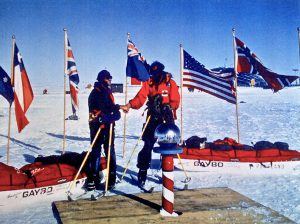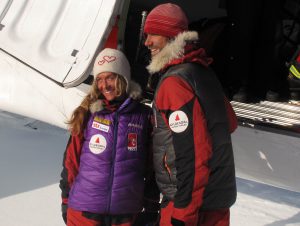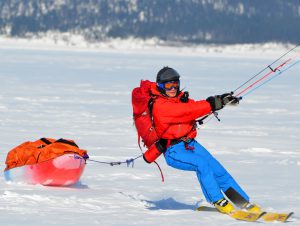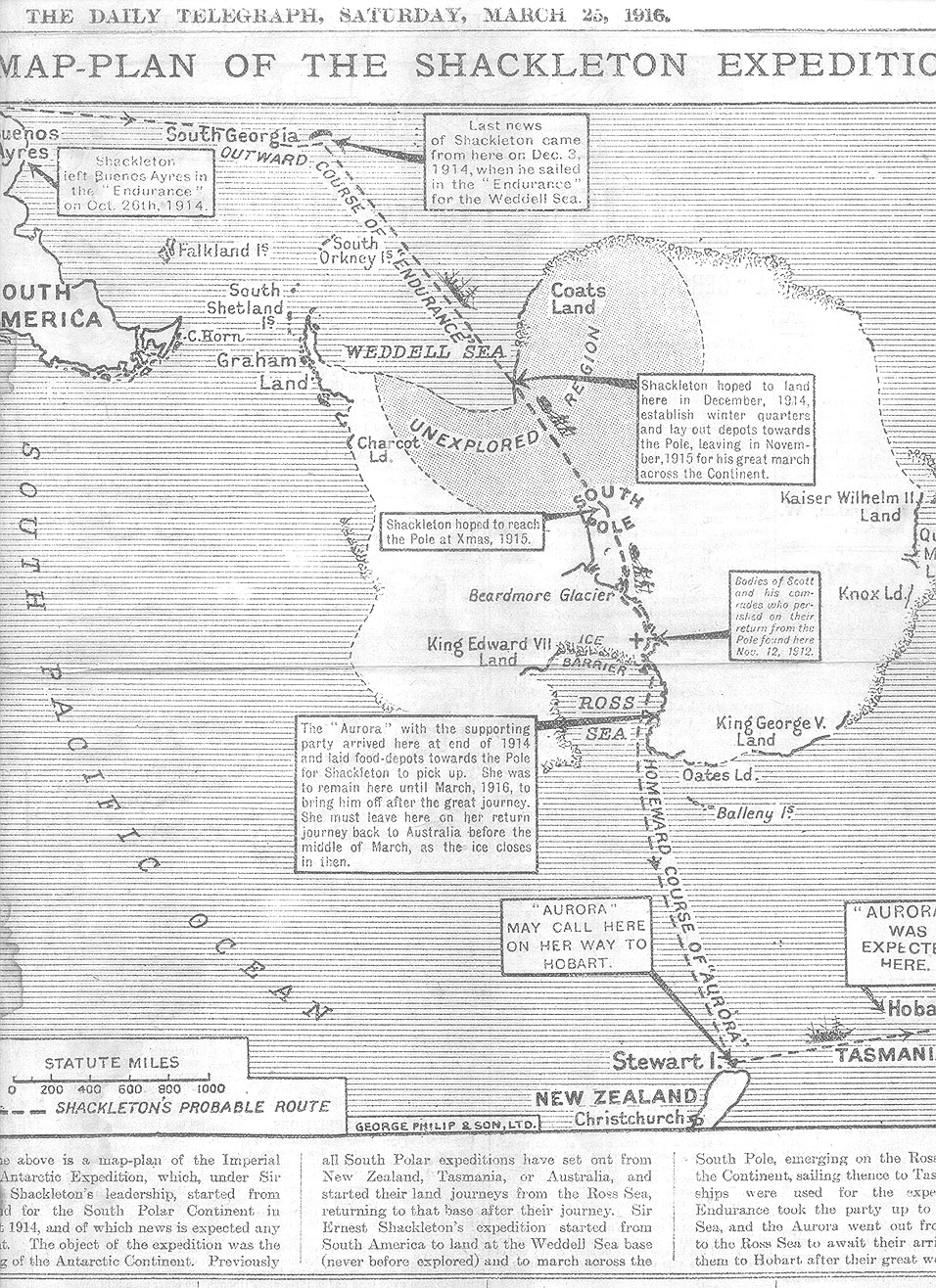2015 marks the centenary of Sir Ernest Shackleton’s Imperial Trans-Antarctic Expedition. Shackleton’s story is one of the most celebrated survival stories of all time and continues to inspire modern day explorers.
Shackleton’s Imperial Trans-Antarctic Expedition Inspires a New Generation
This year, several teams are preparing to undertake the Antarctic crossing he had planned from the Weddell Sea coast to the Ross Sea coast. Luckily, today’s teams can reach their start point by air instead of by sea and avoid having their vessel crushed by pack ice or having to endure a 19 month survival saga. ALE’s Expedition Manager, Steve Jones, describes the legacy of Shackleton’s proposed route on past and future Antarctic expeditions.
Shackleton’s Intended Route
On the opening pages of his book, South, Shackleton discusses the need to find a safe anchorage for the Endurance in the Weddell Sea. He planned to keep the ship over-winter and use it as the quarters for the crew and the scientists while building a hut nearby for the shore party. If all had gone well, three teams would have explored west, east and southwards in the first season (Jan/Feb 1915) and laid depots southwards.
“I had no intention of landing north of Vahsel Bay, in Luitpold Land, except under pressure of necessity. Every mile gained towards the south meant a mile less sledging when the time came for the overland journey.”
– Sir Ernest Shackleton
Shackleton’s intended start point, Vahsel Bay, was the most southerly and best he could find on the Weddell Sea Coast. It was a known anchorage reported by Wilhelm Filchner during his 1912 expedition. Filchner discovered the Luitpold Coast and had also intended to make the first Antarctic overland crossing.
Neither Filchner’s ship the Deutschland nor the Endurance would overcome the pack ice in the Weddell Sea. Both expeditions were prevented from even starting their overland journeys but their planned routes would go on to inspire many explorers to come.
Vahsel Bay Starts
Commonwealth Trans-Antarctic Expedition (CTAE) 1955-58
The first overland traverse from Vahsel Bay was the Commonwealth Trans-Antarctic Expedition (CTAE) 1955-58 led by Vivian Fuchs. The CTAE traveled 2,158 miles (3,473 km) via the South Pole to Scott Base on Ross Island in 99 days.
Argentinian Army 1965 and 1999
Above Vahsel Bay on Bertrab Nunatak, is the Argentinian Base Belgrano II. Two Argentinian Army teams have travelled from here to the South Pole by vehicle and several more have gone as far as their advance base Sobral. In 1965, Operación 90 used Tucker Sno-cats to reach the Pole. This was a major undertaking and involved first establishing the forward base Sobral. In November-December 1999, an Argentinian Army seven man team used snowmobiles to travel to the South Pole from Belgrano II and back. This expedition was led by Lieutenant-Colonel (now General) Victor Figueroa, who is still actively involved in the Argentinian Antarctic Program. They reported a one-way straight line distance of 870 miles (1,400 km) and reported a lot of deviations around difficult terrain. 187 miles (300 km) south of Belgrano II they had great difficulties in a complex crevassed area they called Paso Saravia and they spent a week getting out of it. They reached the South Pole on January 5, 2000.
Berkner Island Starts
Thirteen expeditions have started from Berkner Island, a hundred miles west of Vahsel Bay. The majority of these have skied south along the island before crossing a section of the Filchner Ice Shelf and making landfall in the Dufek Massif. This is south-west of the area where CTAE and the Argentinian expeditions made their landfall on the eastern side of the Support Force Glacier. Eight of the thirteen Berkner Island expeditions stopped at the South Pole. Five attempted full traverses with varying degrees of success.
No expedition to date has completed the exact route that Shackleton planned, but three expeditions have achieved the broader objective of an Antarctic Traverse from the Weddell Sea coast to Ross Island. If a 2015 expedition completes the journey it will be a significant achievement and a worthy commemoration of Sir Ernest Shackleton’s plans.
1989-90 Würth-Antarktis Transversale Expedition
Reinhold Messner and Arved Fuchs intended to start from Berkner Island and make the first complete ski traverse but logistical problems forced their start from the inland coast of the Ronne Ice Shelf. They would go on to ski from the Ronne Ice Shelf to the South Pole to Ross Island via the Beardmore Glacier.
1990 Sjur and Simen Mørdre expedition
This Norwegian expedition was the first to start from Berkner Island. They descended the Axel Heiberg Glacier (not the Beardmore Glacier that Shackleton planned to use) and finished at Ross Island as Shackleton had planned. They had a four man team and two dog sleds as far as the Pole and a three man team and kite-skis from Pole to McMurdo.
1992 Ranulph Fiennes and Mike Stroud
 These two Brits also tried to undertake the complete traverse from Berkner Island to Ross Island but ran out of time and energy and were picked up on the Ross Ice Shelf just beyond Beardmore Glacier.
These two Brits also tried to undertake the complete traverse from Berkner Island to Ross Island but ran out of time and energy and were picked up on the Ross Ice Shelf just beyond Beardmore Glacier.
1993 Monica Kristensen’s Aurora Foundation Expedition ended in tragedy
The four person snowmobile expedition planned to search for Amundsen’s buried South Pole tent and display it at the Lillehammer Winter Olympics in 1994. While travelling unlinked through heavily crevassed terrain on the Support Force Glacier, Egil Isaksen fell into a crevasse and was injured. They set up camp and Jostein Helgestad went to look for a safe route out of the crevasses. He set off on foot, un-roped and fell to his death into a deep narrowing crevasse. The rest of the expedition was rescued by a US-NZ team from McMurdo and the equipment and vehicles were abandoned on the glacier at 81°22’54.9S 014°03’ 52.9W.
1996 Børge Ousland
Ousland accomplished the first complete solo ski traverse of Antarctica, starting from Berkner Island and descending the Axel Heiberg Glacier to finish at Ross Island. His expedition was an extraordinary achievement at the time and is still remarkable today.
1999 Operation Chillout
 Australians Tim Jarvis and Peter Treseder attempted the complete traverse but only got a week beyond the South Pole when a fuel leak spoiled rations and they back-tracked to the South Pole for a pick-up.
Australians Tim Jarvis and Peter Treseder attempted the complete traverse but only got a week beyond the South Pole when a fuel leak spoiled rations and they back-tracked to the South Pole for a pick-up.
2009 Cecilie Skog and Ryan Waters
This duo made the first unsupported (no resupply) unassisted (no kiting) traverse of Antarctica from Berkner Island to the Ross Ice Shelf at the foot of the Axel Heiberg Glacier.
2015 Expedition Route
A 2015 Shackleton Centenary expedition would likely start from Vahsel Bay or Berkner Island. The first section of the Vahsel Bay route crosses the Filchner Ice Shelf. This terrain is challenging because the Ice Shelf moves north .8 miles (1.3 km) a year creating disturbed sections of ice caused by the outflows of the glaciers which feed it. The 1957 and 1965 well-resourced national expeditions had spotter planes but they did not have the high resolution satellite images that are available today. A modern expedition can build on the knowledge of previous routes and study these in conjunction with satellite imagery.
Once expeditions near the South Pole, they must follow a designated route through the facilities of the base area. The South Pole has been designated an Antarctic Specially Managed Area and a detailed management plan guides all activities in the area.
Between the South Pole and the top of the Beardmore Glacier, the route climbs over the higher ground of Titan Dome. This is likely to be the coldest section of the whole route. The Beardmore Glacier was travelled by the 2013 Scott Expedition and the 2008 Nimrod and 2011 Scott-Amundsen Race expeditions led by Lt-Col Henry Worsley giving teams current knowledge to build on.
The actual pick-up point at the end of the journey will be Pegasus Field. In late summer, this is usually more than 10 nautical miles from landfall on Ross Island, around the open water in McMurdo Sound. A centenary expedition should plan to ski to landfall at Ross Island to complete their journey, visit Hut Point if they want to (permit needed), and then ski to Pegasus Field. Late in the summer season, the historic huts at Cape Evans and Cape Royds will likely be inaccessible.
To Kite or Not to Kite?

Kites and ski-sails can allow expeditioners to travel 100 km or more in a day, making them an appealing option. For example, Børge Ousland travelled 140 miles (226 km) in one day on the Ross Ice Shelf. However, relying on the wind has drawbacks. The prevailing katabatic winds are southerlies, flowing downhill from the interior high polar plateau to the coasts. Skiing towards the Pole may not offer many days with winds good for kiting or sailing and the equipment weighs several kilos and takes up space in sleds. Several expeditions have expected to kite-ski long distances across the Ross Ice Shelf, but few have had more than one day with favorable winds.
No matter how you choose to travel, the distance and duration involved in a long Antarctic traverse present many of the same challenges as they did in 1915.
Further reading
South by Sir Ernest Shackleton
The Crossing of Antarctica by Vivian Fuchs & Sir Edmund Hillary
Shackleton’s Dream by Stephen Haddeslsey
Crevasse Roulette by Jon Stephenson
The Crossing of Antarctica, original photographs by Huw Lewis-Jones
The Lost Men by Kelly Tyler-Lewis
Alone Across Antarctica by
Børge Ousland
References
www.lanacion.com.ar/575074-centenario-la-aventura-antarctica
www.marambio.aq/motos.html
www.southpolestation.com/trivia/90s/monicasar.html
www.southpole.aq
